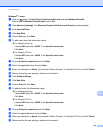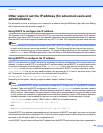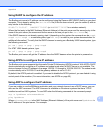
Appendix A
149
A
Other ways to set the IP address (for advanced users and
administrators) A
For information on how to configure your machine for a network using the BRAdmin Light utility, see Setting
the IP address and subnet mask on page 15.
Using DHCP to configure the IP address A
The Dynamic Host Configuration Protocol (DHCP) is one of several automated mechanisms for IP address
allocation. If you have a DHCP server in your network, the print server will automatically obtain its IP address
from the DHCP server and register its name with any RFC 1001 and 1002-compliant dynamic name services.
Note
If you do not want your print server configured via DHCP, BOOTP or RARP, you must set the Boot Method
to static so that the print server has a static IP address. This will prevent the print server from trying to
obtain an IP address from any of these systems. To change the Boot Method, use the machine’s control
panel Network menu, BRAdmin applications, Remote Setup or Web Based Management (web browser).
Using BOOTP to configure the IP address A
BOOTP is an alternative to RARP that has the advantage of allowing configuration of the subnet mask and
gateway. In order to use BOOTP to configure the IP address make sure that BOOTP is installed and running
on your host computer (it should appear in the /etc/services file on your host as a real service; type
man bootpd or refer to your system documentation for information). BOOTP is usually started up via the
/etc/inetd.conf file, so you may need to enable it by removing the “#” in front of the bootp entry in that
file. For example, a typical bootp entry in the /etc/inetd.conf file would be:
#bootp dgram udp wait /usr/etc/bootpd bootpd -i
Depending on the system, this entry might be called “bootps” instead of “bootp”.
Note
In order to enable BOOTP, simply use an editor to delete the “#” (if there is no “#”, then BOOTP is already
enabled). Then edit the BOOTP configuration file (usually /etc/bootptab) and enter the name, network
type (1 for Ethernet), MAC Address (Ethernet Address) and the IP address, subnet mask and gateway of
the print server. Unfortunately, the exact format for doing this is not standardized, so you will need to refer
to your system documentation to determine how to enter this information (many UNIX systems also have
template examples in the bootptab file that you can use for reference). Some examples of typical
/etc/bootptab entries include: (“BRN” below is “BRW” for a wireless network.)
BRN310107 1 00:80:77:31:01:07 192.168.1.2
and:
BRN310107:ht=ethernet:ha=008077310107:\ip=192.168.1.2:
Certain BOOTP host software implementations will not respond to BOOTP requests if you have not included
a download filename in the configuration file. If this is the case, simply create a null file on the host and specify
the name of this file and its path in the configuration file.
As with RARP, the print server will load its IP address from the BOOTP server when the printer is powered on.


















